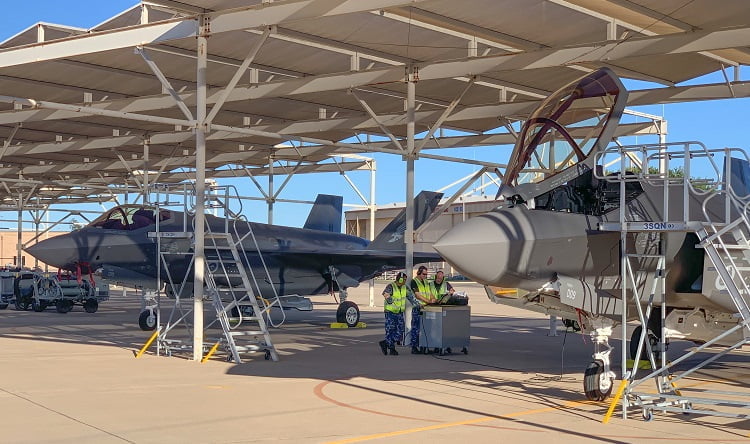By Robbin Laird
The RAAF F-35s on on their way to Williamtown and thereby opening the F-35 Aussie fleet operations in-country.
As the Aussies work out their sustainment approach on the various airbases where the F-35s will operate in normal times as well as crisis times, the F-35 partners of Australia have a significant strategic opportunity — namely, to learn how to do sustained engagement operations working with the RAAF in supporting regional deterrence operations.
The Aussies are standing up a significant support structure in Australia for regional support. As they do so, allies such as the US and Japan can shape an approach to what I would call sustained engagement. With crises to come in which the F-35s will play a key role, the Australians can provide operating locations for allies, without having to base those allies on a long term basis.
This allows Australia its sovereignty but also allows allies like the United States and Japan to gain operational depth which will be crucial for deterrence in the region.
Because they are flying virtually the same aircraft, stockpiling parts and leveraging an expanded sustainment base with the Australian maintainers leading the way for the USAF to move to a new approach to operations which does not require them to operate like Fed Ex flying in resources to then stand up support in a crisis.
The USAF or the Japanese could fly to Australia and be supported by Australian based supplies and maintainers supplemented by Japanese and US maintainers and could operate rapidly in a crisis, rather than engaging in a significant airlift and tanking support set of missions to stand up aircraft in Australia on a case by case basis.
It is not about just showing up; it is about being able to do sustained engagement with a very light expeditionary support structure to establish and operate from a solid operational footprint.
An allied approach towards sustained engagement when married with Aussie rethinking about how to use their geography as well as base mobility creativity would significantly enhance deterrence and operational flexibility in a crisis.
Recently, the Australian National Audit Office provided a look at the current RAAF sustainment approach and gave it a thumbs up but cautioned with regard to the global sustainment piece.
It might make a lot of sense for Australia’s allies to embrace the opportunity to make the global sustainment piece a core strategic effort both for Australia’s requirements but shaping a 21st century approach to deterrence as well.
In a piece published by the Australian Defence Business Review on December 6, 2018, the findings of the ANAO were highlighted.
The Australian National Audit Office (ANAO) has released a report into the ADF’s plans to sustain the RAAF’s fleet of Lockheed Martin F-35A Lightning II fighters.
The audit was commissioned to examine the ADF’s preparations for the F-35A’s introduction to service in light of the imminent arrival and the significant delays and cost increases the program has been through during its development.
Released just five days before the planned official welcome of the first two of 72 F-35As to Australia, the audit report is a generally favourable one, but highlights that some of the sustainment costs of the program remain unknown.
The report summary says the audit criteria were; “Defence has established effective strategic planning and project governance arrangements; and Defence has undertaken effective planning, is achieving progress against relevant plans and effective risk management is occurring for selected capabilities.”
The executive summary states that, “Defence’s preparations to date for the introduction and sustainment of the Joint Strike Fighter (JSF) aircraft into Australian service have been effective with the exception of arrangements for sustainment of JSF aircraft under the Global Support Solution,” with the caveat being, “JSF sustainment cannot be fully costed until the Global Support Solution further matures.”
That maturity is not expected to be realised until after 2020 when the global fleet has achieved a steadier state of commonality and more operators – including Australia – have achieved an initial operational capability (IOC), and the global supply chain has spun up to support higher production volumes.
“Defence has established effective strategic and project governance arrangements to date for the introduction of the JSF into Australian service and its sustainment,” the report adds.
“These arrangements include: plans addressing the transition from the Classic Hornets to the JSF; sustainment arrangements; infrastructure requirements; workforce planning and training; project governance arrangements and procedures for regular engagement with the international JSF Program; and procedures for regular monitoring and reporting on risk, cost and schedule to governance bodies, senior Defence leaders and Defence Ministers.”
For sustainment, the report adds, “Defence is monitoring and managing risks to effective sustainment of the JSF arising from the Global Support Solution including — the availability of spare parts, the development of the Autonomic Logistics Information System, and access to maintenance facilities.
“Defence is constrained in its ability to effectively manage some risks, including access to JSF spare parts due to limited global supply. Not all of the costs associated with Australia becoming a regional hub for JSF aircraft maintenance and warehousing were known by Defence when the project was approved in 2014. This is adding cost pressures to the project.”
Auditor-General_Report_2018-2019_14


